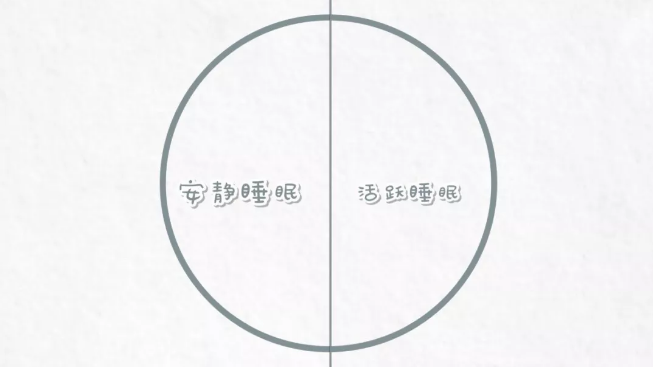There is a kind of collapse, which is called [compared with those who have never slept well, those who sleep backwards will make people doubt life more].
When many mothers talk about their children’s sleep problems, they all mention [sleep retrogression]-babies who have slept regularly, excluding the causes of eating, drinking, pulling and scattering diseases, and suddenly waking up frequently makes people collapse.

In fact, this stage of 3-5 months is the first sleep retrogression period in the baby’s life, which determines 80% of the baby’s sleep quality in the future. It is called the watershed between [sleeping slag] and [sleeping god] babies.
Today, we invited sleep consultant Zhu Xiaojie to talk about how to deal with this most important and difficult retrogression period.
Why is there a sleep retrogression period in April?

The main reason for the 4-month sleep retrogression period is the change of the baby’s sleep mode: from the baby’s sleep mode to the adult’s sleep mode.
Four months ago, the baby’s sleep stage was very simple, with only two levels:
- Active sleep-light sleep, easy to wake up; Quiet sleep-Deep sleep, difficult to wake up.

About 4 months later, the baby’s sleep pattern will [evolve] from the alternation of the previous two sleep stages to the more complicated cycle of the four sleep stages.

The change of sleep mode from easy to hard is a difficult process for your baby, which is also the main reason why babies who have good sleep suddenly love to wake up frequently.
Is the baby sleeping dregs or sleeping gods, how to guide is very critical

At this stage, the babies still have a leap forward in their understanding of [causality].
For example, when beating a toy, the toy will make a sound. When the toy falls to the ground, adults will hear the sound of their crying and help them pick up the toy on the ground.
At this time, the mother is often knocked down by the baby and will use up 18 classes of martial arts to coax her to sleep. The result of the crash between [sleep retrogression] and [causality] is:
The baby cried and slept with milk, hugged and coaxed to sleep again.
Over time, the baby has a causal association: the reason why I can fall asleep again is because of my mother’s milk or because my mother is holding it!
Then, as long as the baby wakes up, he will choose to wait for his mother’s comfort, forgetting that he had the ability to comfort himself and fall asleep to a certain extent.
Once the baby learns this sleep mode, the sleep habits will become more deeply rooted in the future. What was originally a “fake sleep slag” has become a “real sleep slag”.
Many babies suffer from poor sleep at the age of 4 months, largely because the mother’s anxiety leads to excessive comfort and then becomes a new sleep dependence.
Mastering these 4 tricks, you can safely pass the sleep retrogression period in April.

1. Put down anxiety and adjust sleep expectation
The sleep fluctuation at the age of 4 months does not mean that the baby’s sleep ability has regressed. At this time, the mother should believe that the good sleep habits and sleep ability established by the baby when he was young will not disappear overnight.
Therefore, don’t set the sleep goal as [how to make the baby fall asleep], but adjust it to [how to help the baby adapt to the new sleep mode as soon as possible].
2. Improve the baby’s sleep ability
Parents can continue to use the previous effective methods of appeasement for their babies, but do not increase the intensity (duration and frequency) of appeasement, or introduce new and stronger methods of appeasement to make the situation [worse].
For example, for babies who can be comforted by tapping/picking up, the comforting method of giving milk as soon as they cry should be used with caution.
See the following figure for the level of strength and weakness of the appeasement method.

In addition, the baby’s self-soothing ability during sleep needs to be practiced. You can gradually weaken/withdraw the current soothing method to gradually improve the baby’s self-soothing ability. Gentle practice is more suitable for this month-old baby.
3. Establish the “Eat-Play-Sleep” mode
At this stage, establish a [eat-play-sleep] mode to help the baby sleep better and regularly.
4-month-old baby can consider gradually open the eating interval, gradually excessive for 4 hours of eating interval. In 12 ~ 16 weeks, to the baby to introduce nap work and rest rules, it is suggested to arrange three naps a day: morning + afternoon + evening, to help the baby get a proper amount of daytime sleep.

4. Besides sleeping, exercise is also important
Four-month-old babies always practice turning over with their eyes closed. This kind of big exercise development will make the baby’s sleep [even worse]. It is suggested to arrange big exercise practice time at different times during the day to help the baby master turning over as soon as possible.
During the turn-over period, the mother should not tangle and interfere with the baby’s sleeping posture too much. As long as the sleeping environment is safe, it is OK to let the baby try all kinds of sleeping postures.
What if I miss the critical period? Staging [rescue] is the key

What if the mother missed the 4-month-old sleep retrogression period and has formed bad sleep habits?
Don’t worry! There are also ways to [turn sleep residue back into sleep god].
5 ~ 6 months old baby
At this stage, the number of night milk for many babies will increase, and the extra food needs of babies can be met through intensive eating before going to bed.
At the beginning of the addition of supplementary foods for about six months, the baby will also suffer from maladjustment to new foods, such as flatulence, constipation and other conditions, which will affect sleep. When parents are examining factors affecting sleep, please do not ignore this new link of supplementary foods.

7 ~ 9 months (recommended best time)
For families who want their children to sleep in small beds on their own, it is very suitable for the sleep adjustment period after the baby’s supplementary food is added stably and before the baby stands up, because the factors that may affect sleep at this stage are relatively controllable.
For parents at this stage, I suggest that a mild [step-by-step solution] can be considered:
- Firstly, control the number of night milk within a reasonable range (1 ~ 2 times); Secondly, adjust the way and arrangement of adding supplementary foods during the day. Then consider completely abstaining from night milk; The last is to change the baby’s sleep behavior.

10 ~ 12 months
During this period, the baby is in an active stage of major sports development, and it is easy to affect sleep due to such reasons as standing alone, standing alone, sitting up and walking.
If parents decide to adjust the baby’s sleep at this stage, please arrange more targeted large-scale exercise activities for the baby during the day. Make sure that the baby can skillfully switch from standing position, sitting position to lying position before conducting sleep guidance.
This stage of sleep guidance requires parents to give their children more patience and waiting.

More than 12 months old
Physiologically speaking, Babies basically no longer need to eat at night. For babies over one year old, I suggest parents adopt a one-size-fits-all approach. Because for older babies, reducing night milk by lengthening the feeding interval will make them more confused-[whether I have not cried long enough to eat milk].
The advantages of sleep adjustment for children in early childhood are: quick effect and more stable effect.
Some mothers will think that [sleeping slag] and [sleeping god] are both born. In fact, many sleeping slag babies are caused by parents ignoring the needs of their babies and failing to keep pace with their growth.
Know your children better, do not deny yourself, learn to change in better ways, and every family can have happier sleep.
